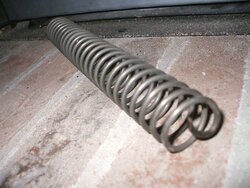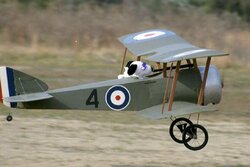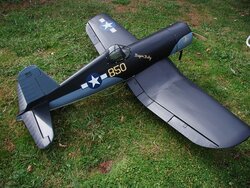For quite a while, I have been thinking of ways to upgrade the caveman technology that Quad uses to transfer heat using the smooth aluminum tubes in their Castile and Sante Fe stoves. The nice round, smooth tubes give the least amount of surface area for heat transfer both on the outside where they are exposed to the fire's heat and inside where they are supposed to transfer heat to the room air. Why they aren't made of corrugated or finned material is beyond me based on the asking price for the stoves. In any event, because of the mechanical wiper system, the outside didn't afford much opportunity for easy improvement. I, therefore, focused on the inside of the tubes looking for ways to break up the assumed laminar flow of air that promotes lousy heat exchange and at the same time increase the surface area exposed to the air flow for more heat transfer.
As an experiment, I purchased from McMasterCarr some 36" long 1 1/4" diameter spring material (9662K46) and cut it into 9" lengths. I then bent the one end so that I could grab it with pliers and push and rotate it clockwise into the 8 center tubes, leaving the first and last tube as is since little air flows through them. Here is hopefully a picture.
Next I let the stove reach steady state at Medium with a flame height just barely out of the fire pot. Then I measured the exhaust temperature just past the quick disconnect on the stove. Finally, starting from the left, I measured the room temperature air coming out of each tube. Then I inserted the springs in tubes #2-9 and waited 1/2 hour for stabilization and then measured everything again. Here are my results:
Exhaust temp before = 170F after = 160F
Tube 1 before = 150F after = 135F
Tube 2 before = 145F after = 152F
Tube 3 before = 140F after = 161F
Tube 4 before = 142F after = 162F
Tube 5 before = 160F after = 158F
Tube 6 before = 160F after = 172F
Tube 7 before = 141F after = 150F
Tube 8 before = 140F after = 150F
Tube 9 before = 160F after = 165F
Tube 10 before = 200F after = 165F
Conclusions > The exhaust temperature appears to show that less heat is going up the chimney, which logically means more is going into the room.
> The exhaust temperature appears to show that less heat is going up the chimney, which logically means more is going into the room.
Tube 1's lower temperature is a bit of a mystery since it is the first tube to see the fire's heat. Very little airflow comes out of that tube so effect is minimal.
Tubes 2 through 9, except 5, show an increase in heat output due, I imagine, from the added surface area and the spiral effect of the air flowing through the tubes and breaking up the laminar flow. Tube 5 was really a wash for increase.
Tube 10 has very, very little airflow through it so it had plenty of time to pick up heat before the exhaust exits the stove. The fact that the temperature dropped dramatically could be and indication that the previous tubes have removed much more of the heat from the exhaust, leaving less to transfer to the tube #10.
Next, I will order enough springs to do my Sante Fe PLUS order a Dwyer Meter, which will supply one important bit of information, the air flow rate out of each tube. This will answer the question as to if the springs severally limit the airflow, which would explain the higher temps. However, the lowering of the exhaust temperature points toward a positive net gain in efficiency.
Sorry it's so long but some may find this interesting. Others may be asleep by now. %-P
As an experiment, I purchased from McMasterCarr some 36" long 1 1/4" diameter spring material (9662K46) and cut it into 9" lengths. I then bent the one end so that I could grab it with pliers and push and rotate it clockwise into the 8 center tubes, leaving the first and last tube as is since little air flows through them. Here is hopefully a picture.
Next I let the stove reach steady state at Medium with a flame height just barely out of the fire pot. Then I measured the exhaust temperature just past the quick disconnect on the stove. Finally, starting from the left, I measured the room temperature air coming out of each tube. Then I inserted the springs in tubes #2-9 and waited 1/2 hour for stabilization and then measured everything again. Here are my results:
Exhaust temp before = 170F after = 160F
Tube 1 before = 150F after = 135F
Tube 2 before = 145F after = 152F
Tube 3 before = 140F after = 161F
Tube 4 before = 142F after = 162F
Tube 5 before = 160F after = 158F
Tube 6 before = 160F after = 172F
Tube 7 before = 141F after = 150F
Tube 8 before = 140F after = 150F
Tube 9 before = 160F after = 165F
Tube 10 before = 200F after = 165F
Conclusions
 > The exhaust temperature appears to show that less heat is going up the chimney, which logically means more is going into the room.
> The exhaust temperature appears to show that less heat is going up the chimney, which logically means more is going into the room.Tube 1's lower temperature is a bit of a mystery since it is the first tube to see the fire's heat. Very little airflow comes out of that tube so effect is minimal.
Tubes 2 through 9, except 5, show an increase in heat output due, I imagine, from the added surface area and the spiral effect of the air flowing through the tubes and breaking up the laminar flow. Tube 5 was really a wash for increase.
Tube 10 has very, very little airflow through it so it had plenty of time to pick up heat before the exhaust exits the stove. The fact that the temperature dropped dramatically could be and indication that the previous tubes have removed much more of the heat from the exhaust, leaving less to transfer to the tube #10.
Next, I will order enough springs to do my Sante Fe PLUS order a Dwyer Meter, which will supply one important bit of information, the air flow rate out of each tube. This will answer the question as to if the springs severally limit the airflow, which would explain the higher temps. However, the lowering of the exhaust temperature points toward a positive net gain in efficiency.
Sorry it's so long but some may find this interesting. Others may be asleep by now. %-P



 )
) :gulp: Please keep us posted! ;-)
:gulp: Please keep us posted! ;-)
